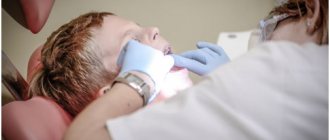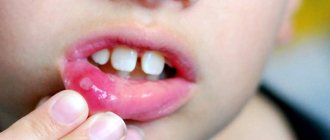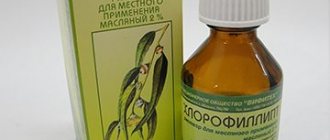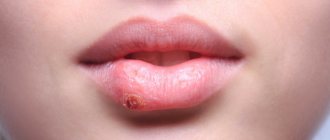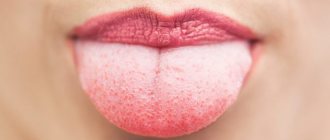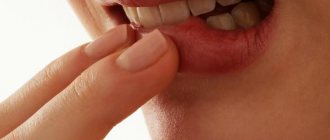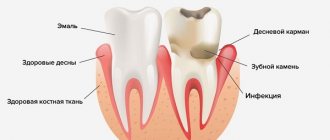Dental diseases include not only various problems with teeth, but also with lips, gums and simply the oral cavity. For example, cheilitis is an inflammation of the mucous membrane of the lips, which is characterized by the appearance of cracks in them. There is simple cheilitis (on the lips) and angular or angular cheilitis (in the corners of the lips), but there are also other types that depend on the causes. These types will be described a little later in the article.
Why do lips dry out?
Before looking for a way to quickly moisturize your lips, you should find out the cause of the problem. Depending on what formed the basis for the lack of moisture, you can choose a suitable remedy for complete restoration.
Causes of dry lips:
- Harmful environment. Cold, heat, windy weather and poor air quality. Cold and heat provoke a decrease in moisture in tissues. The condition worsens during strong winds.
- Stress. Situations when a person is very nervous and involuntarily licks his lips (a standard human reaction). The saliva that covers the delicate skin dries quickly, drying out the problem area.
- Medicines that affect the salivary glands, for example, drugs aimed at reducing appetite.
- Oral care products with high fluoride content. The element is characterized by a dehydrating effect. Thin skin is not able to retain moisture for a long time, as the dermis does on other parts of the body.
- Cosmetics: long-lasting lipsticks, matte formulations, tints and products with a dry/powdery effect. Pigments for artistic makeup. Powdering for better durability of conventional products speeds up drying.
- Unhealthy lifestyle: poor nutrition worsens the situation with vitamin saturation of the whole body. Lack of water (maintaining water balance is the key to health), alcohol, and tobacco are harmful.
- Diseases that cause dry mouth. These include allergic reactions, lip burns, dental diseases, inflammatory pathologies, bacterial and hormonal diseases.
Excessive dryness can be caused by a cold with a profuse runny nose and nasal congestion. With frequent inhalation and exhalation through the mouth, the lips become chapped and dry. During such a period, it is especially important to know how to keep your lips moisturized.
Causes of cheilitis
The inflammatory process can begin for multiple reasons. One of the most common of them is mechanical injuries: for example, accidental biting can cause inflammation.
The development of the disease can also be provoked by:
- unfavorable environment (people who spend a lot of time outdoors and are exposed to wind, frost and other weather conditions are more likely to suffer from cheilitis);
- aggressive action of cosmetics or an allergic reaction to some of their components;
- lack of vitamin B2, which is responsible for the division and growth of epithelial cells;
- diseases of the gastrointestinal tract, liver, lack of immunity.
What should healthy lips look like?
Those who know how to moisturize their lips can boast of their naturally beautiful appearance. The natural red hue is due to the location of blood vessels near the surface.
Signs of healthy lips:
- smooth skin;
- smooth texture;
- pleasant natural shade;
- no peeling or cracking.
Healthy lips have even, uniform pigmentation without light or dark areas. Healthy skin looks elastic, it is not prone to irritation, peeling and allergies.
If a whitened area is detected, it means that the delicate skin does not receive enough hydration or there are not enough vitamins in the body:
- A,
- E,
- WITH.
First you need to learn how to use the right cosmetics. This applies to all people, because even if there are no problems with the lips, a careful attitude will not be superfluous.
You need to be able to choose the right cosmetics. And the first thing people pay attention to is the composition. Oil-based products should contain only natural ingredients:
- jojoba oil,
- cocoa,
- shi,
- nut oils.
It is best to buy products at a pharmacy or labeled “pharmacy product”. This means that cosmetics:
- passed dermatological tests,
- approved by experts
- considered safe.
In addition to moisturizers, there are small life hacks to improve the color and contour of your lips.
Shock freezing is often used: using ice to massage the lips. With prolonged exposure to cold, the appearance of the lips deteriorates, but short periods of exposure to shock cold cause the capillaries to expand sharply. Blood flows closer to the skin and provides:
- more active saturation with oxygen and nutrients,
- more saturated lip color.
The most common advice for lip care is the use of special lipstick. But there are several ways to moisturize your lips without chapstick.
The main symptoms of this disease
To suspect you have cheilitis and consult a dentist, you need to know the symptoms of this disease:
- Lips swell and become inflamed.
- The lips or the border around them become much redder than before.
- Cracks appear in the corners of the lips.
- Sometimes lips peel or crack.
- Sometimes lips become very dry.
- Sometimes your lips hurt or itch.
- Sometimes inflammation occurs in the form of gray or yellow blisters and ulcers (especially in advanced conditions).
As soon as all or some symptoms are detected (as you can see, many do not necessarily appear), you must immediately consult a doctor so that he can conduct the necessary examination, take tests and prescribe treatment.
Herbal and natural active ingredients to treat dry and chapped lips
Lips are an important element for facial beauty, participating in verbal and visual communication, as well as food consumption. However, the skin of the lips is 5 times thinner than the skin of the body, so they need to be given special attention.
The lethal weapon against chapped lips and optimal hydration throughout the day is lipstick! Make it a rule to use paraben-free and paraffin oil-free lipstick because when there is too much of it, the skin rejects it, which increases dryness. Long-lasting shiny, matte or very dark lipsticks can prevent your lips from breathing.
Lip balm can also provide a layer of protection against the adverse effects of wind and cold. It can be used with confidence even when we are staying at home to lock in moisture inside the lips, while providing additional hydration due to the active ingredients it contains (especially if the balm is of good quality and contains essential oils).
Lip balm not only prevents dehydration, but also closes cracks on the lips, thereby preventing them from becoming infected.
Be careful, as many products found in lipsticks and lip balms can cause dehydration and aggravate irritation. This is the case with:
- Aluminum salts, menthol, eucalyptus, phenol and camphor. Menthol, camphor and phenols only cause a state of imaginary comfort, and sometimes even increase dehydration.
- Silicone oil is another very common ingredient (it's also found in lipsticks and glosses for added longevity), but it only promotes dehydration.
- Salicylic acid (although it has proven anti-inflammatory properties) in balms can promote dry lips and flaking.
- If you have acne-prone skin, it is best to avoid cosmetics containing petroleum jelly. Although this substance is very effective for dry lips, some users with acne-prone skin claim that these products can clog pores too much and contribute to the appearance of blackheads.
An equally interesting article: If you do everything correctly, you will forget about diaper rash in your baby!
Powered by Inline
Cheilitis
Clinical manifestations of cheilitis
Exfoliative cheilitis
This type of cheilitis is classified as a group of psychosomatic diseases. It is often diagnosed in children or young adults. Patients usually exhibit two types of psycho-emotional disorders: in the dry form - depressive reactions, in the exudative form - anxious reactions. The disease is always clearly localized - the lesion appears on the red border of the lips and never moves to the oral mucosa and skin around the lips.
Dry form
Patients with the dry form of the disease usually experience congestive hyperemia of the lip border, the formation of dry gray scales, and constant peeling of the lips. The scales are easily removed, but appear again within a week. Patients often complain of severe burning and excessive dryness of the lips. The dry form of the pathology can eventually turn into exudative, which is characterized by greater severity of symptoms.
Exudative form
The exudative form of the disease is usually accompanied by swelling of the lips, pain, and the formation of a large number of scales, which sometimes reach quite large sizes and even hang from the lips. After the scales fall off, a hyperemic surface appears in their place. Patients also complain of sore lips, which makes eating difficult. When diagnosing the disease, the dry form should be distinguished from atopic, allergic and meteorological forms, and the exudative form from exametous cheilitis and lupus erythematosus.
Glandular cheilitis
Glandular cheilitis is an inflammation of the accessory salivary glands, which mainly affects the lower lip. The pathology is often diagnosed in patients over 40 years of age. The primary form of the disease can be triggered by an abnormality of the salivary glands, the secondary form can occur against the background of leukoplakia or lupus erythematosus. Simple glandular cheilitis is characterized by enlargement of the salivary glands, the appearance of red dots on the mucous membrane of the lips, and the active production of serous secretion, which accumulates in the form of dew on the inside of the lips.
In rare cases, patients are found to have a purulent form, which is accompanied by pronounced symptoms and a severe course. The clinical picture of the superficial form of purulent disease is almost the same as with simple glandular cheilitis, only the enlarged salivary glands produce purulent secretion. The deep purulent form of the disease is very difficult. The patient experiences swelling of the lips, the formation of purulent crusts and erosions on the red border. On palpation, severe pain appears.
Contact allergic cheilitis
This type of cheilitis is considered a delayed allergic reaction to chemicals that enter the body through cracks in the lips, then enter the bloodstream and ultimately lead to sensitization of the body. At the same time, the period of sensitization is very individual, since it can range from a couple of days to several years. The duration of sensitization depends on sensitivity to allergens, as well as the state of the endocrine, nervous and digestive systems.
Usually the inflammation is located on the red border of the lips, and also spreads slightly to the skin around them. Erythema appears at the site of contact between the allergen and the skin. Due to inflammation, the patient also develops small blisters, cracks and erosions, which is why he complains of itching, swelling and burning of the lips. The disease sometimes occurs without symptoms; the patient is only bothered by peeling of the lips.
If allergic cheilitis continues for a long time, then usually the red border of the patient’s lips becomes excessively dry, cracks and small furrows form on it. The symptoms of this disease are similar to those of atopic and exfoliative cheilitis, which the doctor must take into account during diagnosis.
Meteorological or actinic cheilitis
Meteorological cheilitis is an inflammation of the surface of the lips, which occurs due to various climatic irritants, including high and low air humidity, wind, and temperature changes. Often this pathology is diagnosed in men because they do not use protective lipsticks. Patients are concerned about the feeling of tightness and dryness of the lips. Damage to the lower lip is also observed - its inflammation and swelling, slight infiltration. Peeling and small scales appear on the red border. It is noteworthy that the lesion does not extend to the oral mucosa and skin around the lips.
As a rule, this chronic disease worsens after exposure to any aggressive climatic factor. It is extremely rare for doctors to diagnose malignancy of the affected area, but precancerous processes are still detected. When diagnosing the disease, it is worth considering that its symptoms are similar to the symptoms of diseases such as atopic and allergic cheilitis.
Atopic cheilitis
Atopic cheilitis refers to inflammation of the red border of the lips, which is considered one of the manifestations of neurodermatitis. The disease occurs due to a genetic predisposition. Allergens can be medications, foods, dust, decorative cosmetics, and pollen.
Often the course of atopic cheilitis is long, the disease either subsides or worsens again. The disease usually goes into an acute stage in the cold season, but in the summer it goes into remission. During periods of exacerbation, patients complain of peeling, redness and itching of the skin of the red border of the lips. Swelling and infiltration of this area also gradually appears.
Excessive dryness and infiltration often lead to cracks, due to which the patient experiences pain when opening the mouth. During remission of the disease, patients experience peeling and thickening of the skin near the red line of the lips. It is noteworthy that inflammation almost never spreads to the oral mucosa. The atopic form of cheilitis must be distinguished from pathologies such as streptococcal cheilitis, contact and allergic cheilitis.
Macrocheilitis
Macrocheilitis refers to swelling of the lips and paralysis of the facial nerve. The attack begins suddenly with swelling of one or both lips at once. At first, patients are bothered by itching of the lip, then they notice that it has begun to grow rapidly. With this type of cheilitis, a shapeless swelling of the lip may occur, it may acquire a bluish tint, and the edges may turn out. Over time, the swelling becomes so large that the lip increases in size three times.
There is uneven swelling of the lips, as one of them appears more swollen than the other. In patients, swelling is constantly observed, but it either increases or gradually subsides. During the day, the intensity of swelling usually changes. Another pronounced sign of the disease is paralysis of the facial nerve. The patient feels an unpleasant sensation in the mouth, the palpebral fissure widens and the corners of the mouth droop due to the loss of tone in the affected part of the face. Usually, incomplete paralysis is observed, since the patient retains autonomic, sensory and motor functions.
More than 60% of patients are diagnosed with a folded tongue, which is considered a developmental abnormality. In this case, there is pronounced swelling of the tongue, which leads to its enlargement. It is worth noting that not all patients are diagnosed with all the main symptoms of this type of cheilitis. Sometimes the disease can manifest itself with just one pronounced clinical sign.
The course of macrocheilitis is always chronic. At the very beginning of the disease, relapses occur, which alternate with long periods of remission. However, over time, the disease becomes chronic, and its exacerbations are extremely rare - usually after stressful situations and viral infections. During diagnosis, this pathology should be distinguished from angioedema, lymphangioma, erysipelas, and hemangioma. Typically, difficulties in making a diagnosis arise when the disease manifests itself with only one leading symptom.
Hypovitaminous cheilitis
Hypovitaminous cheilitis occurs due to a lack of B vitamins. Because of this, signs of the disease appear such as burning and dry tongue. In addition, there is redness and swelling of the mucous membrane, the appearance of cracks and peeling on the red border of the lips. Often the cracks are quite painful and often bleed. With this type of cheilitis, patients' tongue becomes enlarged and teeth marks appear on it.
Symptoms of reactive pancreatitis in children
The intensity of the symptoms of reactive pancreatitis largely depends on the age of the child. In children under three years of age, the signs of the disease are usually mild, while in older children they are more pronounced. The main symptom of reactive pancreatitis in children is pain1.
Pain in the reactive form of pancreatitis is concentrated in the navel area (when asked “where does it hurt,” children most often indicate this exact place). But it also happens that the child points to another part of the abdominal cavity. This is due to the immaturity of children's nervous regulation: the baby may feel like it hurts in different parts of the abdomen. That is why only a doctor can accurately link the presence of pain with the manifestation of reactive pancreatitis.
In older children, pain may radiate to the back, forcing young patients to adopt positions that relieve pain - sitting in a chair, leaning forward, or lying on the left side or stomach1.
In addition to pain, concomitant symptoms of reactive pancreatitis in children appear1:
- nausea and uncontrollable vomiting - first with food, and later with gastric juice;
- frequent loose stools (diarrhea may alternate with constipation);
- a slight increase in temperature to 37-38°C;
- lack of appetite, screaming and loud crying in infants and newborns;
- bloating;
- feeling of dry mouth.
